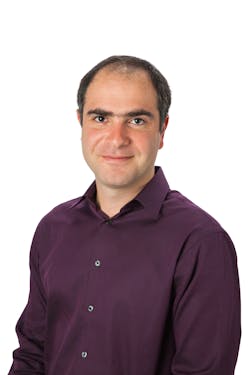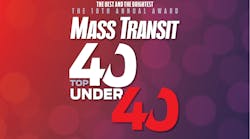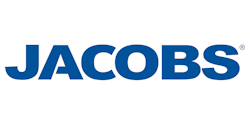- One word to describe yourself: Passionate
- Alma Mater: Michigan State University
- Favorite book: "Rubáiyát" by Omar Khayyám
- Favorite TV show: "House of Cards"
- Favorite movie: "Forrest Gump"
- Favorite hobby(s): Hunting, hiking, fishing and anything outdoors.
- Fun fact about yourself: "I'd like to be a bartender in one of Rio de Janeiro beaches."
- Favorite station or stop that you have ever visited or frequent: Persepolis, Shiraz, Iran
- Favorite route you have ever ridden or frequent (and why): Trail Ridge Road, Rocky Mountain National Park, Colorado
Amirpasha Peyvandi began his career as a bridge engineer, involved in a variety of simple to complex and challenging projects that provided a fast-track rise to senior level in the past nine years. He is a senior bridge engineer in Jacobs’s Englewood, Colorado, office with transportation group.
Peyvandi approaches daily interactions with bridge department staffs as learning opportunities, which has helped develop talented engineers with strong abilities. His experiences include development of project design criteria, design of new structures with wide range of structural systems. His responsibilities include manage and guide junior-level engineers and technical staff during the design and production of final plan documents and provides QC/QA review.
Peyvandi’s experience extends to the implementation of ultra-high-performance concrete (UHPC) — a subject on which he based part of his PhD study. For most of the nation’s departments of transportations, UHPC is an exciting new construction material. It’s something that DOTs were interested in using in a new accelerated bridge construction (ABC) method.
He was an adjunct professor in the Civil Engineering Department at Louisiana State University (LSU). His key responsibilities included teaching fundamental engineering courses, as well as advance courses.
Peyvandi is a multi-talented researcher/engineer with highly-developed advanced expertise in concrete, and cement materials coupled with background in industry and academia who is establishing an enviable record of accomplishment in civil and structural engineering. Over the past decade Peyvandi’s research in advanced concrete materials, green nanocomposite infrastructural materials, and structural design has established him among the very best structural researcher/engineers.
He participated in federally funded studies, including research into recycled glass concrete, efficient and durable infrastructure systems, and green high-performance concrete nanocomposites.
His work has led to the introduction of glass-enhanced concrete pavement with superior durability, impermeability, and cost-effectiveness; novel microbial corrosion-resistant synthetic fiber-reinforced concrete; and demonstration of modified graphite nanoplatelet-enhanced concrete that is more resilient and has better structural characteristics than legacy formulations. He has not only improved current formulations but expanded the applicability of his findings to provide researchers, engineers, and designers with more corrosion resistant, lighter, stronger, and cheaper concretes for infrastructure systems. Throughout, Peyvandi has demonstrated a unique skill package that encompasses the development of advanced concrete materials, nanomaterial and nanocomposite-enacted green cement formulations, and structural design of infrastructural components, bound together with a wealth of industry experience and cutting-edge civil structural engineering expertise.
In order to carry out his research, Peyvandi was one of five nationwide recipients of a $20,000 award from the Precast/Prestressed Concrete Institute in 2013. In addition, he received competitive fellowship awards from Michigan State University for his Ph.D. studies. He also received 2016 Rising Stars in Structural Engineering award from Civil engineering magazine.
As additional evidence of his achievement and expertise, he has published more than 25 peer reviewed papers in journals like ACI Structural, PCI, Concrete International, ASCE Journal of Infrastructure Systems, and etc., attended many industry conferences and conducted half a dozen research projects.
He also invited as a lead guest editor for the “Journal of Advances in Mechanical Engineering” for proposed 2016 special issue on “Application of Nanomaterial in Mechanical Engineering."
“'Expertise in every field is valuable and admirable,' my father used to say. At that time, I was too young to understand the real meaning of this sentence. Perhaps, the Golden Gate Bridge of that 1000-piece puzzle, which I was presented by my father as a birthday present at my 14th birthday, enlightened me about the deep meaning of expertise. That very day, I decided to do the bridge puzzle, anticipating a future in which I would be able to design and build a real bridge."
"I think challenges and identifying appropriate solutions for them we as bridge engineer experiencing on almost daily basis would be the interesting part of our job."
"We should watch every single detail and aspect of our works from designing to plan production, as at the end of the day, all these deal with [people's lives] and public safety."
"Back to my PhD career, I developed a locomotion mechanism which enables unmanned vehicles to move on different surfaces including up-side down ones. This invention is now using by industry. I know this may not be a bridge engineering related things but as a structural engineer I like the idea behind what I personally developed."
"I believe my knowledge and experiences in this field help [people live] more comfortable and safer."





